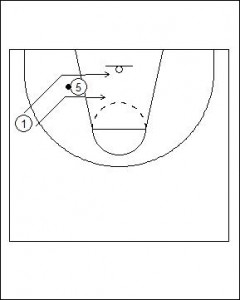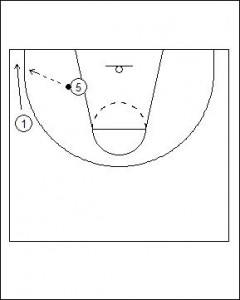Passing into the Post: Perimeter Player after the Pass
Passing into the post has a number of difference tactical elements. In the first instance passing into the post starts with the perimeter player. Then focus moves to the interior player and how offense is generated. The next phase within this two man game is the perimeter player’s movement after the pass.
A very common issue that is faced by teams and coaches alike is after the pass has been made into the post, the perimeter player stands still. All the way from junior to senior and onto professional teams this is a very significant problem.
Moving means defensive players guarding the perimeter player are less likely to double down into the post or even hedge and recover into the offensive post player’s space. When the defensive player does make a decision to double down on the post player it is then up to the offensive perimeter player to make the right reading leading to the best possible shot.
Passing into the post like the on-ball screen has a number of different phases. The perimeter player after the pass still should be thinking about looking for scoring opportunities and what they can do to find the best possible outcome for their team. This won’t be done if the passer does not move or continue to be an active part in the overall offense.
There are a few different options the perimeter player has when they pass into the post. All of these should be exposed to your players so they are able to make the appropriate “read” to execute the best possible scoring option.

The first option we will have a look at is the cut to the basket. This is one of the more popular actions out of passing into the post at the moment with many team offenses having this as a regular movement within their patterns, not just an option executed on a “read”. As the pass is executed the offensive perimeter player creates a lead before cutting off either shoulder of the post player. In this action the post player can be used to run interference with the cutters defensive player. Additionally, the pass between the two players can be performed as a hand-off or as a pass when the cutter is past the post player.
This read is a great option when the defensive player attempts to double into the post or comes out of a defensive stance.
The cut to the basket does not have to finish with a lay-up, but maybe a shot from the elbow or edge of the keyway.

Another possible option is for the perimeter player after passing into the post to relocate to space. For example if the pass is to the low post from the wing the perimeter player might relocate to the baseline three –point line. This is effective in creating space for the shooter while moving the ball to the post which will be seen as a higher threat and then passing away from the basket for the shop.
The read for this option is about the personnel involved. This shot needs to be within the range of the perimeter player. Giving a poor shooter, a good shooting position, is still a poor offensive option.

After passing into the post the perimeter player can screen away from another perimeter player. This player then has an option of cutting off the screen into space. You will see this option performed very well within the Euroleague as a reliable and often used offensive movement. Alternatively within this action the cutter also can change the action and cut directly to the basket. Each option that is changed within this pattern will make it harder and harder for the defensive team to restrict one particular player or movement. As a result most defensive teams will try to match-up more intensely which will allow for more effective isolation tactics.
Some of the other options include the pass from the post leading to an on-ball screen or the perimeter player who is passing into the post be screened for off the ball. All of these options can be utilised to great effect, but a fundamental focus on the movement will be needed to promote players continuing to be involved in the offense even when they don’t have the ball in their hands.






Leave a Reply